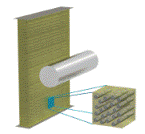Mechanical and Materials Engineering, Department of

Department of Engineering Mechanics: Dissertations, Theses, and Student Research
First Advisor
Jeffrey E. Shield
Date of this Version
Spring 5-2010
Document Type
Thesis
Citation
A thesis presented to the faculty of the Graduate College at the University of Nebraska in partial fulfillment of requirements for the degree of Master Science
Major: Engineering Mechanics
Under the supervision of Professor Jeffrey E. Shield
Lincoln, Nebraska, May 2010
Abstract
Rare-earth, high-energy permanent magnets are currently the best performing permanent magnets used today. The discovery of single domain magnetism in 1950’s ultimately led to the development of nanocomposite magnets which had superior magnetic properties. Previous work has shown that mechanical milling (MM) effectively generates nanoscale structures in Sm-Co-based alloys. MM of more Co-rich, melt-spun Sm-Co alloys (up to the eutectic composition) and the role of initial structure on the milling behavior were investigated.
Sm-Co alloys with compositions of Sm10.5Co89.5 and Sm8Co92 were produced by arc melting, melt-spinning and mechanical milling. X-ray diffraction results showed that the as-melt spun materials formed in the disordered TbCu7-type variant for both compositions, and that FCC-Co is also present in Sm8Co92. At long milling times, FCC-Co developed in the Sm10.5Co89.5 alloy. MM resulted in a decrease of grain size, indicated by the broadening of the x-ray diffraction peaks. However, the samples remained crystalline, as peaks characteristic of the TbCu7-type structure were always present. The grain sizes obtained in both compositions ranged between 10-20 nm. Scanning electron microscopy images showed that the powder particles contain agglomerates and that a broad micron-scale particle size exists in the samples. The coercivity of both samples initially increased with increasing milling time, reaching plateau values of ~4.6 kOe and 1.6 kOe for Sm10.5Co89.5 and Sm8Co92, respectively. The lower coercivity values of the Sm8Co92 alloy were due to its more Co-rich composition.
Advisor: Jeffrey E. Shield


Comments
Copyright 2010, Farhad Reza Golkar-Fard. Used by permission